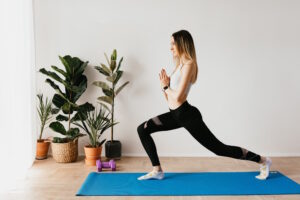
Pilates is a highly effective and low-impact exercise method that can be practiced in the comfort of your own home. Whether you’re a dedicated Pilates enthusiast or a newcomer to this fitness discipline, setting up a home Pilates studio can provide convenience, flexibility, and the opportunity to maintain a consistent practice. In this guide, we will explore the steps and considerations involved in creating a home Pilates studio and address common questions related to running a Pilates studio from home.
Can you run a Pilates studio from home?
Yes, you can run a Pilates studio from your home, but there are several important factors to consider:
1. Licensing and Certification: Ensure that you are a certified Pilates instructor or have the necessary qualifications to teach Pilates professionally. Many regions require instructors to hold certifications to operate a studio, even from home.
2. Zoning and Regulations: Check local zoning laws and regulations. Some areas may have restrictions on running a business from a residential property. You may need a permit or approval to operate a home-based studio.
3. Insurance: Obtain liability insurance to protect yourself and your clients in case of accidents or injuries that may occur during sessions.
4. Equipment and Space: Invest in high-quality Pilates equipment and ensure you have sufficient space for both the equipment and client sessions.
5. Marketing and Client Acquisition: Develop a marketing plan to attract clients to your home studio. Consider online marketing, social media, and word-of-mouth referrals.
6. Client Privacy: Ensure the privacy and security of your clients by maintaining professional boundaries and protecting their personal information.
How to create a Pilates studio at home?
Creating a Pilates studio at home involves several steps and considerations:
1. Select a Suitable Space:
· Choose a room or area in your home that is quiet, well-ventilated, and free from distractions.
· Ensure adequate lighting for safe and effective Pilates practice.
2. Invest in Pilates Equipment:
· Essential equipment includes a Pilates mat, resistance bands, Pilates ball, and a set of hand weights.
· For a more comprehensive setup, consider purchasing a Pilates reformer, Cadillac, or Wunda chair.
3. Design and Layout:
· Organize your equipment in a logical and accessible manner.
· Create a clean and inviting atmosphere with ample space for movement.
4. Safety Measures:
· Install mirrors to help clients maintain proper form and alignment.
· Ensure that the flooring is non-slip and provides sufficient cushioning.
5. Online Presence:
· Create a website or social media profiles to promote your home Pilates studio.
· Share information about your qualifications, services, and pricing.
6. Scheduling and Booking:
· Implement a scheduling system for clients to book sessions.
· Offer flexible hours to accommodate different schedules.
7. Client Communication:
· Maintain clear and professional communication with clients, including session confirmations and reminders.
8. Client Privacy and Safety:
· Establish guidelines for client safety and privacy, including sanitization procedures and health protocols.
9. Client Experience:
· Prioritize the client’s experience by providing individualized attention and personalized workouts.
Is owning a Pilates studio profitable?
The profitability of owning a Pilates studio, whether at home or in a commercial space, depends on various factors, including location, clientele, overhead costs, and pricing. Here are some considerations:
1. Location: A studio located in a densely populated area with a demand for Pilates classes is more likely to be profitable.
2. Clientele: Building a loyal client base and retaining clients is key to profitability. Offering quality instruction and a positive client experience can help.
3. Overhead Costs: Managing overhead costs, such as rent, utilities, equipment maintenance, and insurance, is crucial. Home-based studios may have lower overhead, potentially increasing profitability.
4. Pricing: Setting competitive and reasonable pricing for your services is essential. Consider your local market and the value you provide to clients.
5. Marketing: Effective marketing and client acquisition strategies can contribute to profitability. Invest in marketing efforts that reach your target audience.
6. Online Services: Offering virtual Pilates sessions can expand your client base and revenue potential.
Ultimately, owning a profitable Pilates studio requires a combination of business acumen, effective marketing, high-quality instruction, and a strong client-focused approach.
What is the minimum size for a Pilates studio?
The minimum size for a Pilates studio can vary depending on the equipment and the type of sessions you plan to offer. For a basic home Pilates studio, a room or dedicated space of approximately 100 to 200 square feet can be sufficient. This should allow ample space for a Pilates mat, essential equipment like resistance bands and hand weights, and enough room for clients to move comfortably.
However, if you plan to incorporate larger equipment such as a Pilates reformer, you’ll need more space. A reformer typically requires an additional 60 to 80 square feet. Therefore, for a fully equipped home Pilates studio with a reformer, a space of 160 to 280 square feet or more would be ideal.
In commercial settings, Pilates studios can vary significantly in size, ranging from small boutique studios to larger facilities with multiple rooms and equipment options. The size of your studio should align with your business model and the types of classes or sessions you plan to offer.
In summary, creating a home Pilates studio involves careful planning, adherence to local regulations, and investment in equipment and marketing. While the profitability of a Pilates studio can vary, a focus on quality instruction, client satisfaction, and sound business practices can contribute to success. The minimum size for a Pilates studio depends on the equipment and services you intend to provide, but for a basic home setup, 100 to 200 square feet is a reasonable starting point.